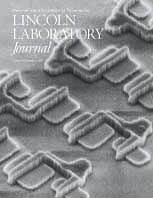Publications
Volume 10, Number 1
 |
|
Theory and Experimental Results of a New Diamond Surface-Emission Cathode A new electron-emission mechanism combines the enhanced electric field of a triple junction at the intersection of metal and diamond interfaces in vacuum with the negative electron affinity (NEA) of the diamond surface. This new surface-emission mechanism is compared to two common cathode mechanisms—geometric electric-field enhancement and Schottky-diode electric-field enhancement with an NEA semiconductor. Unlike these two mechanisms, in which electrons tunnel from metal into vacuum or into the conduction band of an NEA semiconductor, in our mechanism electrons tunnel from metal into surface states at the interface of an NEA semiconductor and a vacuum. Once in these states, the electrons are accelerated to sufficient energies to be emitted from the surface into vacuum. New cathodes designed to maximize the surface-emission mechanism exhibit improved consistency and reduced operating voltage. Photolithography at 193 nm For the last two decades photolithography has been the principal technology for patterning the progressively smaller and denser features required in microelectronic devices and circuits. In recent years, the increasing sophistication of photolithographic techniques using radiation at wavelengths comparable to the feature size has enabled the mass production of circuits in which critical dimensions are 0.25 μm. The drive to smaller dimensions is expected to continue in the future to critical dimensions of 0.18, 0.13, and even 0.07 μm, which necessitates a shift to radiation at shorter wavelengths. Lincoln Laboratory has been at the forefront of the development of next-generation photolithographic technology, namely, the use of 193-nm laser radiation. This article presents the rationale behind the transition to this new wavelength, and reviews the status of critical issues encountered in its implementation as a manufacturing process. These issues concern the suitability of optical materials and coatings for lens fabrication, the use of photoresists and wafer processing for device fabrication, and the outlook for extending the usefulness of 193-nm lithography to printing at critical dimensions approaching 0.1 μm. Automated English-Korean Translation for Enhanced Coalition Communications This article describes progress on automated, two-way English-Korean translation of text and speech for enhanced military coalition communications. The goal is to improve multilingual communications by producing accurate translations across a number of languages. We have chosen an interlingua-based approach to machine translation that readily extends to multiple languages. In this approach, a natural-language understanding system transforms the input into an intermediate-meaning representation called a semantic frame, which serves as the basis for generating output in multiple languages. To produce useful, accurate, and effective translation systems in the short term, we have focused on limited military-task domains, and have configured our system as a translator's aid so that the human translator can confirm or edit the machine translation. We have obtained promising results in the translation of telegraphic military messages in a naval domain, and have successfully extended the system to additional military domains. The system has been demonstrated in a coalition exercise and at Combined Forces Command in the Republic of Korea. From these demonstrations we learned that the system must be robust enough to handle new inputs, so we have developed a multistage robust translation strategy, including a part-of-speech tagging technique to handle new words, and a fragmentation strategy for handling complex sentences. Our current work emphasizes ongoing development of these robust translation techniques and extending the translation system to users in the Republic of Korea. |
|